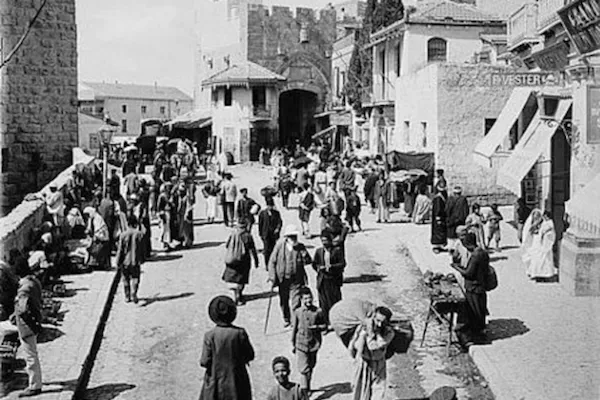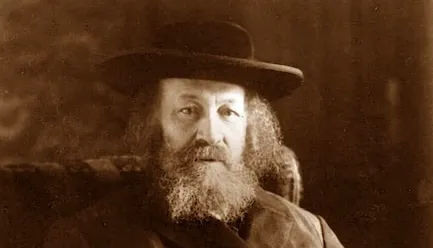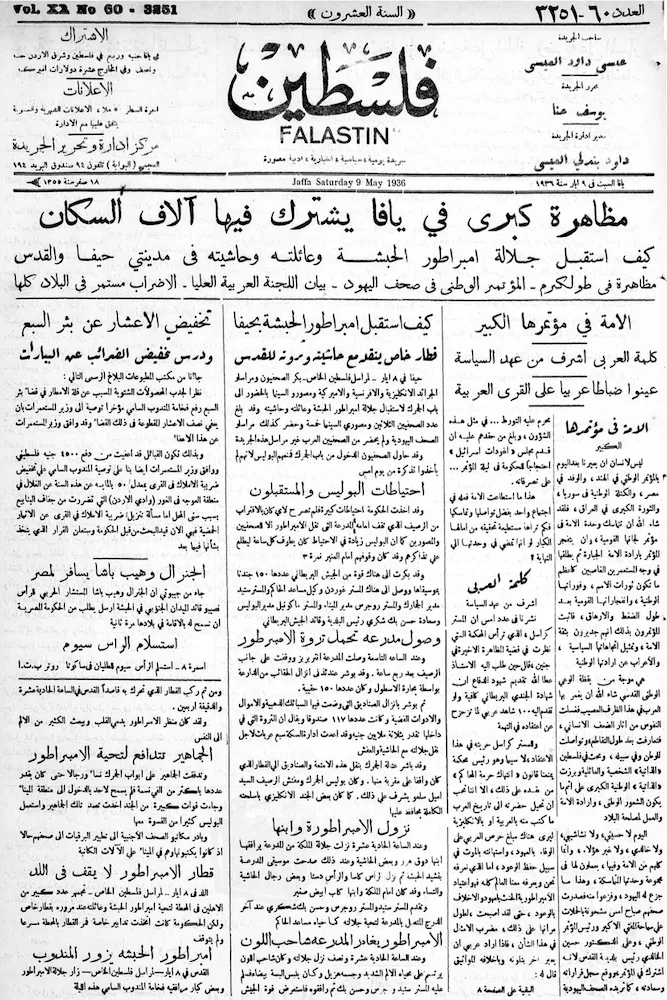Arrival of Zionists
Colonial Zionism
Section titled “Colonial Zionism”In the latter part of the 19th century, a new movement amongst the elite of secure Jews emerged. Zionism in its colonial form sought a safe haven from European anti-Semitism, looking for a territory where it could redefine Judaism as a nationality.
In 1896, Theodor Herzl, the founding thinker of the current colonial project, published “Der Judenstaat” (The Jewish State), a pamphlet that argued for the establishment of a Jewish state as a refuge for Jews. Herzl had an epiphany regarding the need for a Jewish state emerged amidst the antisemitism he witnessed as a journalist in France. He concluded that the Jewish people would never be fully accepted in European societies and that the only solution was the establishment of a Jewish colony.
As Zionism gained political awareness through Herzl’s efforts, it also began to draw more pronounced criticism. Throughout centuries of years of Jewish history, traditional Jewish teachings advocated that the establishment of Israel would only come with the return of the Messiah. Herzl beliefs were rejected traditional Orthodox Jews has trying to usurp the role of the Messiah and was considered as counterproductive (and it was likely to increase not decrease antisemitism) by secular Jews.
Herzl, adept in contemporary politics, advocated for a Jewish state in Palestine, believing it aligned with Europe’s interests (i.e. to rid the continent of its ‘Jewish problem’). His convening of the first Zionist Congress in 1897 marked a pivotal moment, creating a global Zionist congress and local organizations to advance Jewish colonisation of Palestine.
In the end it was the intervention of powerful colonial empire, Great Britain, with a long history of Christina Zionism, that made the most significant impact on Herzl’s dream. Zionist leader, Chaim Weizmann, helped convince the British Prime Minister, Arthur Balfour, to promise Palestinian land (which they had recently captured from the Ottoman) to the Zionists – this was articulated in the Balfour Declaration in 1917. Edwin Montagu, one of the leading Jewish members of the party to which Balfour belonged, and only the third Jewish minister in British history commented on the draft of the Balfour’s declaration:
“I wish to place on record my view that the policy of His Majesty’s Government is anti-Semitic and in result will prove a rallying ground for Anti-Semites in every country in the world.”
August 23, 1917, Montagu Memo on the Anti-Semitism of the British Government
Arrival of Zionists in Palestine
Section titled “Arrival of Zionists in Palestine”For centuries, Jews, Muslims and Christians had been living together under Ottoman rule. Many Jews had escaped to the Ottoman Empire to flee from persecution in Europe. For the most part they were welcomed by the inhabitants. However, this began to change with the more increasingly aggressive settlement approach advocated the Zionist movement. A central myth put by forward by modern Zionist colonialists is that Palestine was an “empty land” awaiting its chosen people is in stark contrast with the clear historical record. In reality, Palestine was a land rich in culture and life, with Palestinians having long established their communities, cultivated the land, and developed social structures.
An Inhabited Land
Section titled “An Inhabited Land” Jerusalem, 1898: Ottoman Palestine was a melting pot of different cultures.
Jerusalem, 1898: Ottoman Palestine was a melting pot of different cultures.
At first, first Zionist settlers arrived in small numbers. These pioneers were confronted with a reality starkly different from the propagated myth of a desolate land awaiting its rightful inhabitants. A report by a Zionist delegation vividly described Palestine as “a bride, beautiful but married to another man”1 acknowledging the presence of an indigenous population. This acknowledgment, however, did not deter the Zionist movement, which proceeded with its colonial agenda, indifferent to the rights and existence of the native community.
Ilan Pappe, writes in his book the ‘Ten Myths About Israel’:
The initial interaction between the Zionist settlers and the Palestinians was characterized by a profound sense of disconnection. The settlers viewed the natives not as a people with their own history and rights but as mere elements of the landscape, similar to trees and rocks. This dehumanization was rooted in the ideological framework of Zionism, which perceived the land of Palestine as preordained for Jewish settlement, reducing the native population to mere obstacles in the path of this destiny.
Opposition from local Jewish leaders
Section titled “Opposition from local Jewish leaders”As Zionists arrived en masse, the Orthodox Jews already living in Palestine were unsettled by these largely secular newcomers. The chief rabbi of Jerusalem, Joseph Hayyim Sonnenfeld, harshly criticized the Zionists, likening them to ruffians and declaring that their arrival brought turmoil to the Holy Land.
The Orthodox Jewish community’s spokesman in Jerusalem, Dr. Jacob Israël de Haan was also disturbed by the anti-Arab nature of the Zionist leaders, he was in the process of negotiating an agreement with Arab leaders to allow for the unrestricted immigration of Jews escaping persecution in Europe to Palestine in return for rejecting the Balfour Declaration. However in 1924, de Haan was assassinated by Avraham Tehomi from the Zionist militia, the Haganah, for these efforts. At the time, the assassination was blamed on Arabs, however decades later was it revealed that the Zionist leaders had themselves ordered the assassination. It was in fact Yitzhak Ben-Zvi (who became the second President of Israel) who commanded the assassination to be carried out. The same Hagnah would eventually turn into the ‘Israeli Defence Force’.
The rise of the Nazis and the 1929 Palestine riots created a crisis among the anti-Zionist Orthodox Jews. Senior Jewish figures like Yitzhak-Meir Levin and Jacob Rosenheim were torn, knowing an alliance with Arabs would not sit well with European Orthodox Jews, yet they were reluctant to align with Zionists.
By 1937, the Agudath Israel in Palestine, while concerned about secular Jewish rule, hinted at accepting a Jewish state governed by religious law. Their statement opposed any move to secularize the Holy Land, insisting on a state guided by Torah.
Facing the dire situation of European Jewry, some Orthodox Jewish groups began cooperating with Zionist organizations. This led to a split in 1938 within the community, with some forming the Neturei Karta, who refused any dealings with Zionists.
In 1947, the Chief Rabbi of Jerusalem, Yosef Tzvi Dushinsky, appealed to the UN, requesting that Jerusalem not be part of a Jewish state and instead be placed under international governance.
 1947: Chief Rabbi of Jerusalem appeals to the UN against Zionist agenda
1947: Chief Rabbi of Jerusalem appeals to the UN against Zionist agenda
Palestinian Resentment against British rule
Section titled “Palestinian Resentment against British rule”The arrival and actions of the early European Zionist settlers fundamentally altered Palestinian society. This impact was not merely physical, through land confiscation and displacement, but also deeply psychological and cultural, challenging the very existence and identity of the Palestinian people in their ancestral land. Eventually the local Palestinian population revolted against the colonial powers in the Arab Revolt in 1936. The revolt was put down by 1939, with over 5000 Palestinians killed by the British Forces with the support of Zionist militia. The British Government response involved harsh military measures and restrictions on Arab leadership, further fuelling resentment amongst the Arab population.
 9 May 1936: Falastin (or ‘Palestine’) reporting on the Arab revolt in Palestine
9 May 1936: Falastin (or ‘Palestine’) reporting on the Arab revolt in Palestine
The Mass Migration of Zionists from Europe
Section titled “The Mass Migration of Zionists from Europe”By 1945, over half a million Zionists had settled in a land of about two million Palestinians. Many arrived with the blessing of the European rulers whilst others did not. The indigenous inhabitants, whose voices went unheard, had no say in the scheme to transform Palestine into a Jewish homeland. Over time, the influx of Zionists fed into the increasing resentment felt by the local Palestinian population. The settlers had acquired a mere 7 percent of the territory, insufficient for a sovereign state, and they remained a minority, making up just a third of the population in a land they wished to claim entirely for themselves.
For the Zionists, the only path to extend their dominion beyond the 7 percent and to secure a racial majority was to expel the indigenous people from their ancestral lands. Like other colonial campaigns, this solution was rooted in the idea of dehumanisation the native population and their culture. This first manifested itself in physical subjection but eventually turned ethnic cleansing of Palestinian Arabs from the territories that they wished to claim.
Palestinian historian Nur Masalha writes in his book, Palestine – A Four Thousand year History:
